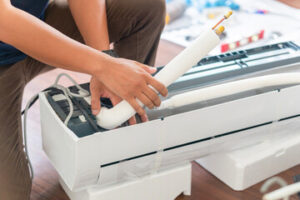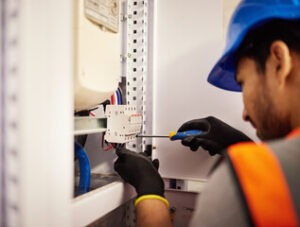Cincinnati Air Conditioning is a vital component in the daily lives of most homeowners, providing relief from scorching temperatures. However, there are various types of air conditioners available, and choosing the right one requires a thorough assessment of your cooling needs.

Air conditioning is one of the biggest energy guzzlers in homes, consuming 6 percent of all electricity and costing homeowners an average of $29 billion each year. Making smart choices when it comes to your home cooling system can save you money and make a positive impact on the environment. Look for energy-efficient models with high SEER ratings and Energy Star certifications.
The SEER rating measures how efficiently an AC unit converts energy into cooling performance. The higher the rating, the more efficient.
Newer units have ratings up to 21 SEER, while older systems are typically 13-15 SEER. SEER is just one of the ways to evaluate energy efficiency; it’s also important to consider other factors, such as climate conditions, usage patterns, ductwork design, and the level of insulation in your home.
Efficient air conditioners will generally require less maintenance than conventional models, reducing overall operating costs. Additionally, a high SEER rating can help qualify you for a rebate from your utility company.
An air conditioner with a higher SEER rating may require more up-front cost than a model with a lower SEER rating, but the additional expense will pay for itself in energy savings. The federal government’s ENERGY STAR program defines a cost-effective product as one that has annual and lifetime energy savings from avoided energy costs, discounted to present value, that exceed the incremental upfront cost of a more-efficient product.
Using an air conditioner with a high SEER rating can significantly reduce your energy use, and incorporating other strategies can increase your savings even further. For example, keeping blinds or curtains closed during peak sunlight hours will limit the amount of cool air needed in a home. Also, using a fan with the air conditioner can help spread cool air throughout a space and minimize electricity use. Lastly, you can further lower your energy consumption by having your home tested for air leaks and properly insulated. For more information, see our Home Insulation and Air Leaks guide.
Space-Saving Design
Air conditioning technology has gotten slimmer and sleeker as it’s integrated into home interiors. People want the system to look modern and fit into the design without disrupting the aesthetic. This is especially important for commercial applications, where delivering an outstanding product experience is vital.
This is why it’s crucial for air conditioner designers to keep up with consumer trends. They should understand what kind of homes the target audience lives in, and choose a unit with an appropriate size that fits into the space. It’s also vital for HVAC engineers to consider energy efficiency and other features that support the design and enhance customer experience.
One example of an effective design is the wall-mounted units that are often used in homes with limited space. These devices mount directly on the walls and don’t take up floor or cabinet space, so they are an excellent choice for homeowners who prioritize aesthetics. They also tend to be less noisy than other types of AC systems.
Another option is to use a ceiling cassette, which is a compact and unobtrusive indoor unit that’s ideal for homes with tight spaces. These units can be recessed into the ceiling and feature individual louvre control so they don’t interfere with the overall design of the room. They are also one of the most energy-efficient options available.
While the use of air conditioning isn’t new, it has become increasingly common as technology advances and consumers demand better and more efficient cooling systems. Fortunately, digital solutions like h2x Engineering’s Air Conditioning Design Software are leading the way for better air conditioning designs that meet today’s needs while keeping up with future advancements.
Smart Connectivity
If you have a smart AC system, you can monitor it through your smartphone. You can even control it with your voice! Many models are compatible with your other smart home devices, allowing you to use Google Assistant or Alexa. This integration makes your life a little easier, and you can save time and effort by not having to go from room to room to adjust the temperature.
One of the best benefits of smart air conditioning is its energy-saving capabilities. With Wi-Fi enabled systems, you can track exactly how much energy the system consumes each hour, day, and month. This allows you to see what is consuming most of the electricity, which can help you avoid spikes in power consumption and prevent a surprise on your next energy bill.
Another way smart air conditioning helps save money is by adjusting the temperature based on occupancy, eliminating waste when nobody is in the room. This feature can also be used to set reminders for maintenance tasks like filter replacements, which helps you keep the AC in top shape and extend its lifespan.
Smart ACs often come with predefined modes that are tailored for certain scenarios like “Sleep Mode” for nighttime comfort, and Eco Mode for energy efficiency. Additionally, they may offer geolocation tracking to detect when you are getting close to home, and automatically switch on your heating/cooling to prepare for your arrival.
Lastly, some smart ACs come with automatic error diagnosis and troubleshooting, which can be helpful in avoiding costly repairs and improving overall performance. You can access this diagnostic information from the app, and some systems even come with the option to automatically notify a technician when an error has been detected.
Smart ACs are a must-have for any modern home, offering a wide range of convenience and cost saving features. To learn more about this technology and how it can benefit you, contact us at DeZiel Heating & AC today! Our experienced technicians are happy to answer any questions you have and show you how a smart air conditioning system can enhance your lifestyle.
Remote Controls
Using an air conditioning remote control is a convenient way to adjust your air conditioner settings from a distance. It lets you set your desired temperature, fan speed, and more without having to get up from your seat. It also saves energy by keeping your home cooler, which reduces electricity usage and costs. This is especially important in Singapore, where the weather is hot and humid year-round.
Most air conditioner remote controls work with infrared (IR) or radio frequency (RF) signals, which transmit messages between the device and the remote. The aircon’s IR or RF detector then changes the appliance’s settings based on your commands. For more advanced smart AC remotes, you can also link them to your Wi-Fi or Bluetooth devices via a remote docking station or app. This allows phone-based control and remote updates as well as integration with other smart home devices.
Many air conditioners feature a timer button, typically marked with a clock icon, which allows you to schedule operation of the air conditioning system at specific times. This programmable function enhances comfort and helps you save money on energy consumption by controlling operation times when your household is not at home or asleep.
Other remote control functions that enhance comfort include a ventilation mode adjustment, which lets you change the airflow direction and air pressure. You can also set a sleep mode to keep your home cool during the night, and turn it off when you wake up in the morning.
Smart air conditioning remotes with improved AI can better understand your habits and preferences to automatically adjust your HVAC system settings. They may also have built-in sensors to monitor your home’s humidity and other environmental factors.
The most common problems with air conditioner remotes relate to signal issues, which often occur when the IR or RF signals cannot reach your device due to obstructions or interference from other wireless gadgets. You can resolve these issues by clearing the path between your remote and the device and ensuring that the batteries are fresh. If the problem persists, you can consult an expert for repair or replacement.



